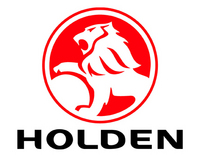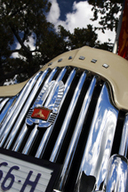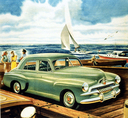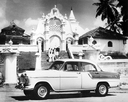Australia's Holden Celebrates its 60th Anniversary
 |
In the Beginning - 1948-1958 - Holden's first Decade of Australian Cars
 Holden 48-215 |
1948-1958 was a decade which saw Holden complete the challenge of building the nation’s first successfully mass-produced car and rapidly expand to meet the growing order bank. It was also when Holden began its first export program, shipping FJ models to New Zealand.
Sites for the Holden Proving Ground in Lang Lang, Victoria, Holden Service Parts Operations (HSPO) in Dandenong, Victoria, and Holden Vehicle Operations (HVO) in Elizabeth, South Australia, were all established in this era.
48-215 – 1948-1953
On 29 November 1948, 1,200 men and women, including Prime Minister Ben
Chifley, gathered around a modest-looking motor car. The ivory-coloured
car, which had been waiting behind silver curtains, was revealed to the
sound of a 10-piece orchestra. The car was the first Holden, a completely
new six-cylinder sedan destined to become Australia’s first
successfully mass-produced car.
 Holden 48-215 grille |
It was powered by a high-torque 2.15-litre engine and weighed less than 1000kg – an equation that added up to a low-cost family car with excellent fuel economy and performance. It was also highly durable, well sealed against dust and stood up to the job on rough, unsealed Australian roads.
The waiting list for the 48-215 rapidly increased as word spread about its remarkable performance, and Holden reacted by expanding production from modest numbers in the closing months of 1948 to 100 units a day by 1951.
48-215 facts:
• Base price at introduction: $1466/£733
• Total number built: 120,402
• Models: Sedan, Business sedan and utility
• Engine: 2.15-litre six-cylinder
• Dimensions (sedan): Length: 4370mm, Wheelbase: 2616mm, Width: 1702mm.
• Power output: 60bhp/45kW @ 4000rpm
• Transmission: Three-speed manual gearbox
Also in 1948-53:
• Only 112 48-215s were produced by the end of 1948, and the enormous customer demand surprises
everyone. Thousands of orders were taken and Holden made every effort to
increase production as quickly as possible.
• In 1950, production of 48-215 was lifted to 80 units a day. Holden employed more than 10,000 people at
sites around Australia.
• Holden purchased 60 hectares of land in Dandenong, Victoria, for future development. It would later
become the HSPO site.
• In 1951, Holden introduced its first utility model, based on the 48-215. In the meantime, strong
demand for the 48-215 continued and production reached 100 units per
day.
Holden FJ – 1953-1956
 Holden FJ - the inspiration for today's Holden Efijy concept car |
Holden distinguished the FJ with more features, more chrome and a greater range of options. It replaced the vertical grille with an elaborate horizontal chrome design, and fitted new hubcaps, bumpers and bright metal body decorations, including small chrome fins on the rear guards.
 Holden FJ |
The accessory list expanded with FJ and the colour range lifted to twelve choices. The new Special model featured armrests and a cigarette lighter and was available with a two-tone exterior paint finish.
The launch of a panel van in 1953 raised production to 200 units per day.
FJ facts:
• Base price at introduction: $2046/£1023
• Total number built: 169,969
• Models: Standard sedan, Business sedan, Special sedan, panel van and utility.
• Engine: 2.15-litre six-cylinder
• Dimensions (sedan): Length: 4408 mm, Wheelbase: 2616mm, Width: 1702mm.
• Power output: 60bhp/53kW @ 4000rpm
• Transmission: Three-speed manual gearbox
Also in 1953-56:
• The first Holdens were exported to New Zealand.
• Holden purchased 870 hectares
of land in Lang Lang, Victoria, to establish Australia’s first
automotive testing and proving ground.
• The first Holden CKD
(completely knock down) kits were shipped to New Zealand for local
assembly.
Holden FE – 1956-1958
 Holden FE in Fiji |
With its fully Australian-designed body, the FE introduced a more angular style and was longer, lower, wider and more powerful than the immensely popular FJ model it superseded.
The FE Series was the product of a £4 million investment and four years of design and development work. It introduced the first wagon, or ‘Station Sedan’, in the 1957 and consolidated Holden’s position as Australia’s most popular car.
 Holden FE Ute |
Engine power was boosted to 53kW, while suspension and handling were improved by such additions as a front stabiliser bar, new springs and better steering. Interiors were also appreciably roomier.
The FE Holden range also featured a fresh new range of ‘single and two-tone fashion colours’, restyled interiors with a more up-to-date dashboard design, a 12-volt electrical system, twin tail and stop lights and electric turn signals on Special sedans and wagons. Optional extras included reversing lights, windscreen washers and front screen demister.
FE facts:
• Base price at introduction: $2284/£1142
• Total number built: 155,161
• Models: Standard sedan, Special sedan, Business sedan, Standard station
wagon, Special Station Wagon, panel van and utility.
• Engine: 2.15-litre six-cylinder
• Dimensions (sedan): Length: 4470 mm, Wheelbase: 2667mm, Width: 1701mm.
• Power output: 70bhp/53kW @ 4000rpm
• Transmission: Three-speed manual with synchromesh on second and third.
Column mounted shift lever.
Also in 1956-58:
• Holden’s Dandenong(Victoria) body and assembly plant was opened.
• The Lang Lang ( Victoria) Proving Ground began operations.
• Holden passenger cars accounted for almost 50 per cent of total registrations.
• The total number of Holdens produced since 1948 exceeded 500,000.
GM Holden in 2008
2008 is a diamond year for GM Holden which will be
recognising a number of key anniversaries. These include: the 60th
anniversary of Australia’s Own Car – the 48-215; the 50th
anniversary of the founding of Holden Vehicle Operations at Elizabeth; 40
years since the introduction of Monaro; 30 years of the Commodore
nameplate; and the General Motors centennial.


